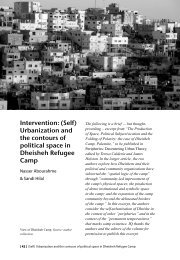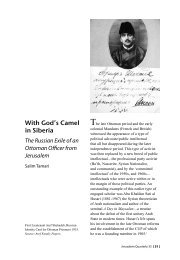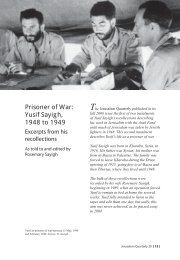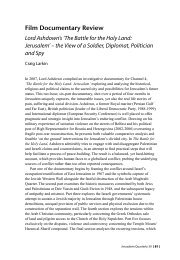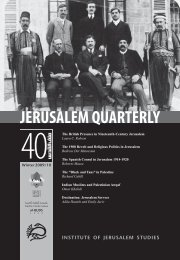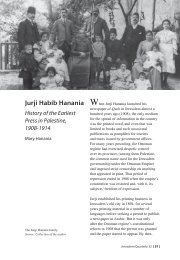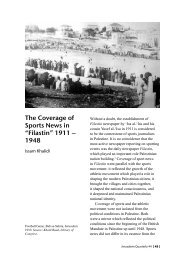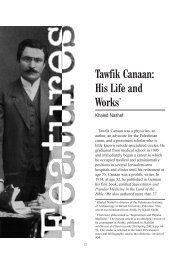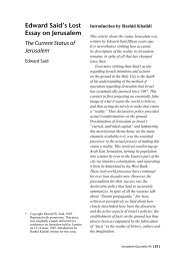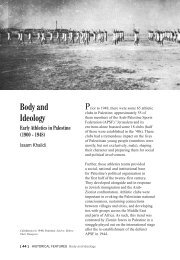PLUNDERING PALESTINE - Jerusalem Quarterly
PLUNDERING PALESTINE - Jerusalem Quarterly
PLUNDERING PALESTINE - Jerusalem Quarterly
You also want an ePaper? Increase the reach of your titles
YUMPU automatically turns print PDFs into web optimized ePapers that Google loves.
A fundamental question that continues to intrigue many Palestinians today is how<br />
it was possible for the Jewish minority in Palestine in 1948 to defeat the majority<br />
of Palestinians and drive them away from their land. Pappe writes of several tactics<br />
that were used in this regard of which I (and I would suspect many Palestinians)<br />
were totally ignorant. These same tactics continue to be in use today, mainly against<br />
the Palestinians living in the territories occupied by Israel in 1967. They include the<br />
following:<br />
• Preparing intelligence files on a large number of Palestinian villages in Palestine.<br />
Pappe tells us that by the late1930s “the ‘archive’ was almost complete. Precise<br />
details were recorded about the topographic location of each village, its access<br />
roads, quality of land, water springs, main sources of income, its sociopolitical<br />
composition, religious affiliations, names of its mukhtars, its relationship with<br />
other villages, the age of individual men (sixteen to fifty) and many more.“ (p. 19)<br />
Similar files with the same information now exist about all the villages in the West<br />
Bank and the Gaza Strip. Pappe adds that:<br />
the final update of the village files took place in 1947. It focused on creating<br />
lists of ‘wanted’ persons in each village. In 1948 Jewish troops used<br />
these lists for the search-and-arrest operations they carried out as soon as<br />
they had occupied a village. That is, the men in the village would be lined<br />
up and those appearing on the lists would then be identified, often by the<br />
same person who had informed on them in the first place but who would<br />
now be wearing a cloth sack over his head with two holes cut out for his<br />
eyes so as not to be recognized. The men who were picked out were often<br />
shot on the spot. (p 21)<br />
A similar practice was used in the 1982 Israeli invasion and occupation of South<br />
Lebanon to determine who would be taken for imprisonment in the Ansar and<br />
Khayyam prisons that Israel had established. It continues to be used in the West<br />
Bank and Gaza to identify those who would become victims of Israel’s policy of<br />
‘targeted killings’.<br />
• The use of collaborators is linked to another tactic reminiscent of the creation of a<br />
network of informers, also commonly used by the Israeli occupation. One of those<br />
involved in this effort, Moshe Pasternak, recalled many years later that by 1943<br />
“there was a growing sense that finally they had a proper network of informants in<br />
place.”<br />
• A third practice that proved of extreme significance in “the building of an efficient<br />
military organization was training with the help of sympathetic British officers.”<br />
<strong>Jerusalem</strong> <strong>Quarterly</strong> 33 [ 67 ]



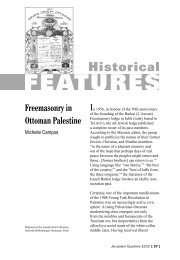
![In Search of Jerusalem Airport [pdf] - Jerusalem Quarterly](https://img.yumpu.com/49007736/1/180x260/in-search-of-jerusalem-airport-pdf-jerusalem-quarterly.jpg?quality=85)
